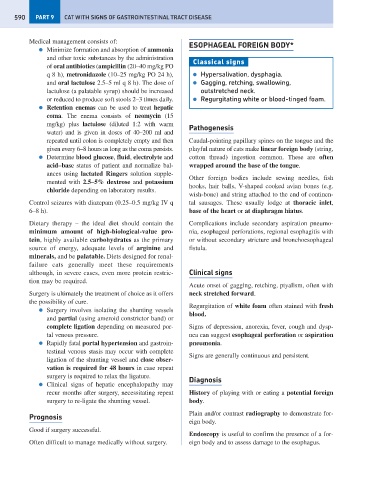Page 598 - Problem-Based Feline Medicine
P. 598
590 PART 9 CAT WITH SIGNS OF GASTROINTESTINAL TRACT DISEASE
Medical management consists of:
ESOPHAGEAL FOREIGN BODY*
● Minimize formation and absorption of ammonia
and other toxic substances by the administration
Classical signs
of oral antibiotics (ampicillin (20–40 mg/kg PO
q 8 h), metronidazole (10–25 mg/kg PO 24 h), ● Hypersalivation, dysphagia.
and oral lactulose 2.5–5 ml q 8 h). The dose of ● Gagging, retching, swallowing,
lactulose (a palatable syrup) should be increased outstretched neck.
or reduced to produce soft stools 2–3 times daily. ● Regurgitating white or blood-tinged foam.
● Retention enemas can be used to treat hepatic
coma. The enema consists of neomycin (15
mg/kg) plus lactulose (diluted 1:2 with warm
Pathogenesis
water) and is given in doses of 40–200 ml and
repeated until colon is completely empty and then Caudal-pointing papillary spines on the tongue and the
given every 6–8 hours as long as the coma persists. playful nature of cats make linear foreign body (string,
● Determine blood glucose, fluid, electrolyte and cotton thread) ingestion common. These are often
acid–base status of patient and normalize bal- wrapped around the base of the tongue.
ances using lactated Ringers solution supple-
Other foreign bodies include sewing needles, fish
mented with 2.5–5% dextrose and potassium
hooks, hair balls, V-shaped cooked avian bones (e.g.
chloride depending on laboratory results.
wish-bone) and string attached to the end of continen-
Control seizures with diazepam (0.25–0.5 mg/kg IV q tal sausages. These usually lodge at thoracic inlet,
6–8 h). base of the heart or at diaphragm hiatus.
Dietary therapy – the ideal diet should contain the Complications include secondary aspiration pneumo-
minimum amount of high-biological-value pro- nia, esophageal perforations, regional esophagitis with
tein, highly available carbohydrates as the primary or without secondary stricture and bronchoesophageal
source of energy, adequate levels of arginine and fistula.
minerals, and be palatable. Diets designed for renal-
failure cats generally meet these requirements
although, in severe cases, even more protein restric- Clinical signs
tion may be required.
Acute onset of gagging, retching, ptyalism, often with
Surgery is ultimately the treatment of choice as it offers neck stretched forward.
the possibility of cure.
Regurgitation of white foam often stained with fresh
● Surgery involves isolating the shunting vessels
blood.
and partial (using ameroid constrictor band) or
complete ligation depending on measured por- Signs of depression, anorexia, fever, cough and dysp-
tal venous pressure. nea can suggest esophageal perforation or aspiration
● Rapidly fatal portal hypertension and gastroin- pneumonia.
testinal venous stasis may occur with complete
Signs are generally continuous and persistent.
ligation of the shunting vessel and close obser-
vation is required for 48 hours in case repeat
surgery is required to relax the ligature.
Diagnosis
● Clinical signs of hepatic encephalopathy may
recur months after surgery, necessitating repeat History of playing with or eating a potential foreign
surgery to re-ligate the shunting vessel. body.
Plain and/or contrast radiography to demonstrate for-
Prognosis
eign body.
Good if surgery successful.
Endoscopy is useful to confirm the presence of a for-
Often difficult to manage medically without surgery. eign body and to assess damage to the esophagus.

